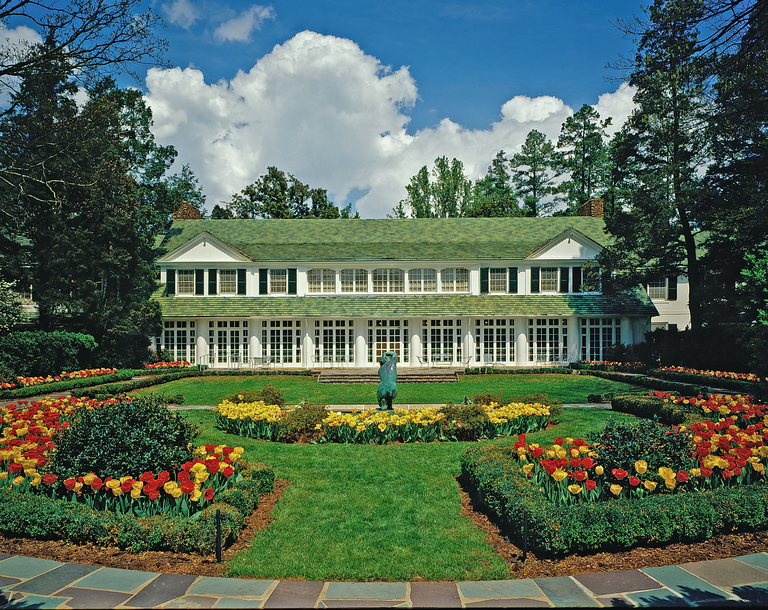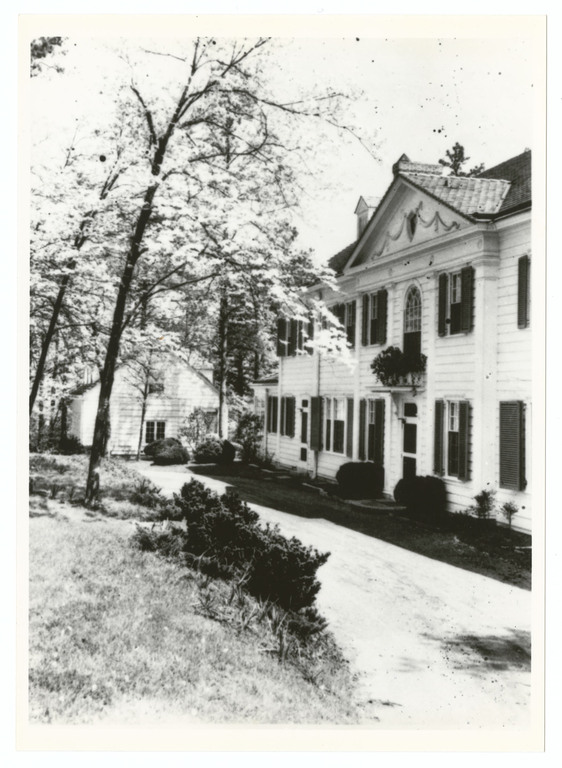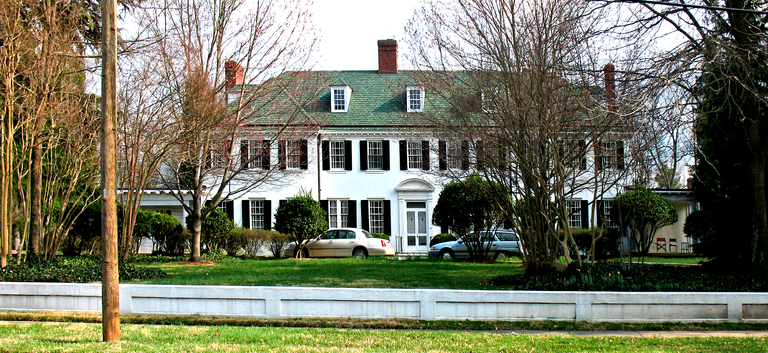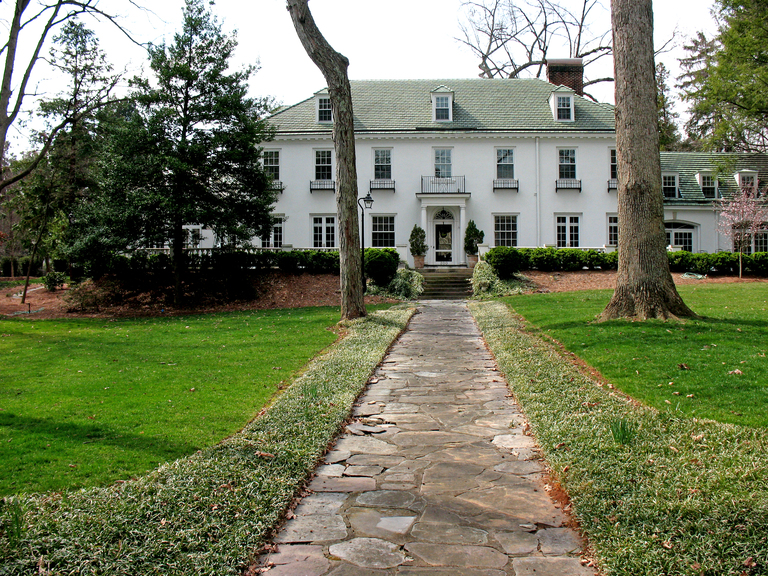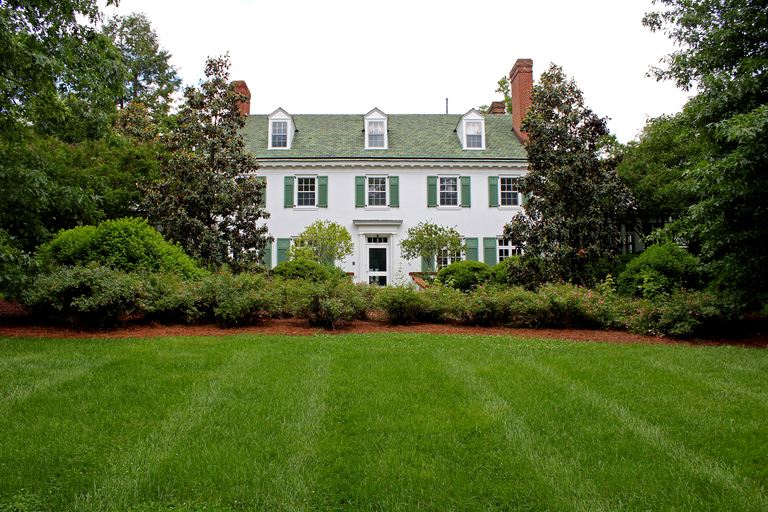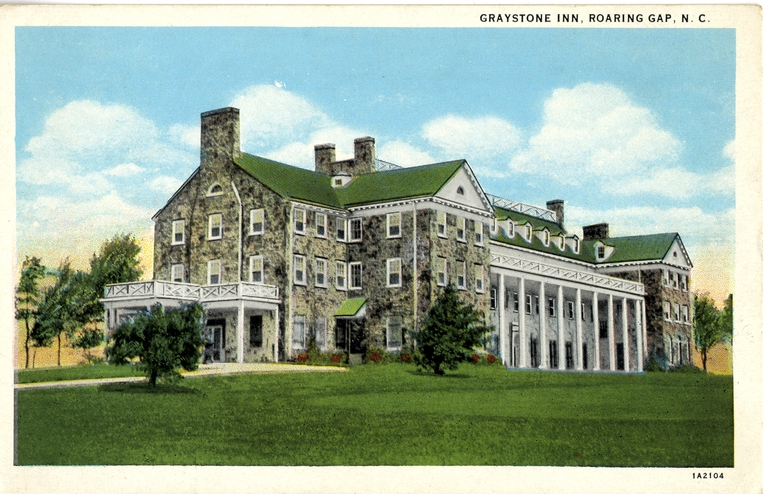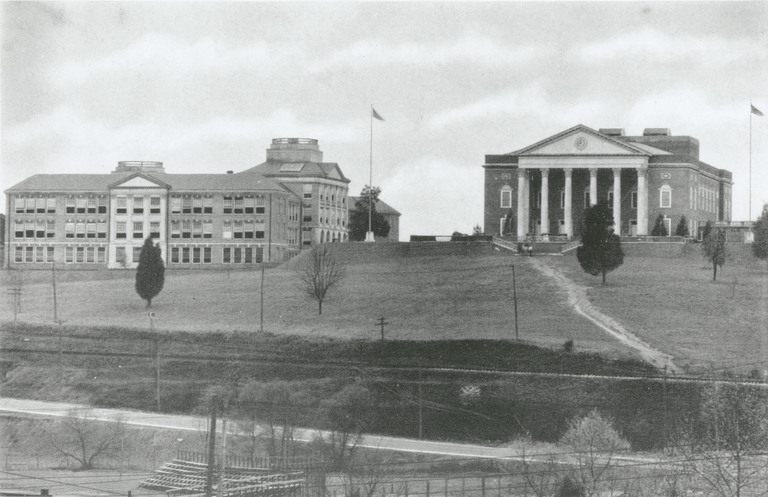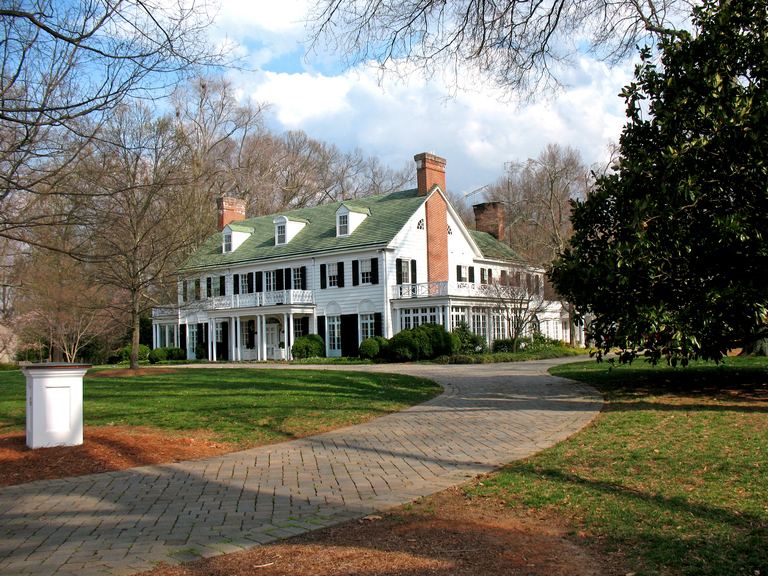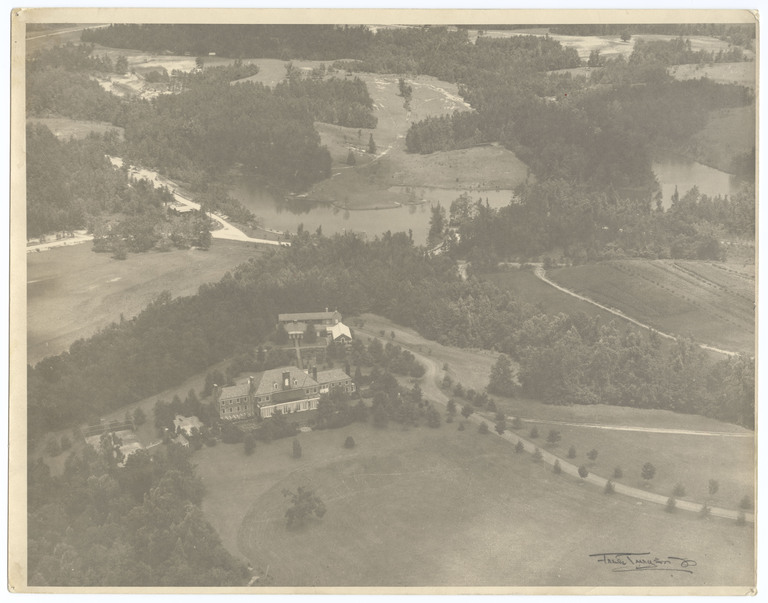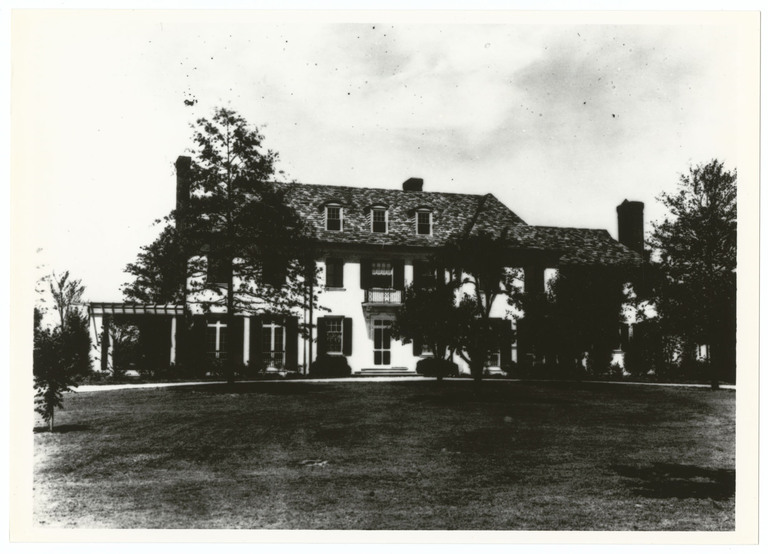Keen, Charles Barton (1868-1931)
Birthplace:
Philadelphia, Pennsylvania, USA
Residences:
- Winston-Salem, North Carolina
- Strafford, Pennsylvania
- Philadelphia, Pennsylvania
Trades:
- Architect
Building Types:
Styles & Forms:
Arts and Crafts; Beaux-Arts; Bungalow; Colonial Revival; Georgian Revival; Spanish Colonial Revival; Tudor Revival
Charles Barton Keen (1868-1931), a prolific designer of suburban residences and country estates primarily on Philadelphia’s Main Line for more than thirty-five years, added a second locus of activity—North Carolina—when he became a favorite architect of wealthy tobacco and textile families starting around 1912. In several of his projects in North Carolina he was associated with landscape architect Thomas Sears. His best-known project in the state is Winston-Salem’s Reynolda (1912-1917) for Katharine and R. J. Reynolds. On the strength of that commission he found a wider clientele associated with the state’s unprecedented industrial wealth of the early twentieth century and who in the 1910s and 1920s were advancing the national trend from downtown living to country houses or newly created elite suburbs.
Born and educated in Philadelphia, Keen was the youngest of three sons of Harriet Emily Ide and banker Charles Burtis Keen. He studied architecture at the University of Pennsylvania (B. S. 1889) just prior to the formal establishment of Penn’s school of architecture. After travel in Europe, he worked for a year (1889) as a draftsman for Penn’s architectural school’s founder Theophilus P. Chandler; he then worked for two years (1890-92) for his cousin Frank Miles Day, an English-trained architect, Arts and Crafts advocate, and one of the three founders in 1901 of House and Garden, a monthly magazine of country house architecture. Keen also took classes at the Pennsylvania Museum and School of Industrial Art (1890-1891; 1891-1892), along with his future partner and colleague in Day’s architectural studio, Frank E. Mead (1865-1940).
Keen and Mead’s early practice (1893-1900) was primarily residential. Exploring an eclectic mix of Spanish Revival, Georgian Palladian, and Arts and Crafts motifs, the young architects designed semi-detached (duplex) houses for real-estate developers in the inner suburbs of Philadelphia as well as grander dwellings in Radnor and other prestigious suburban towns known for their locations along the Main Line of the Pennsylvania Railroad northwest of the city. They hit their stride with Swarthmore Lodge, an Arts and Crafts bungalow connected by a pergola to its hilltop landscape setting in Bryn Mawr, which was the first feature in the inaugural issue of House and Garden (June 1901). The partnership ended when Mead moved to San Diego, eventually to partner with Irving J. Gill and Richard Requa. Keen was left with an established practice that included country estates, summer places, and suburban residences in and near Philadelphia, Pittsburgh, Atlantic City, and Saratoga Springs.
Keen’s amiable nature, social skills, and design expertise surely appealed to his clients, many of whom commissioned several projects from him over the years. Gregarious and athletic, in his student days at Penn he participated in an array of collegiate sports, social clubs, and elected offices. He became an avid and accomplished golfer, and at the 1920 winter tournament at Pinehurst, North Carolina, he won his division as a member of the prestigious Pine Valley Golf Club. He was a regular exhibitor of the T-Square Club, an important venue for informal design competitions and professional fellowship of the Philadelphia Chapter of the American Institute of Architects. His early designs appeared in many books on country houses and in periodicals from Architectural Record to House and Garden_to the _Ladies’ Home Journal.
Keen was one of many architects working on Philadelphia’s Main Line, which had become an influential center of suburban and country house design at the turn of the twentieth century. Like other Philadelphia country house architects including Wilson Eyre, Horace Trumbauer, William L. Price, Brognard Okie, and Mellor, Meigs and Howe, his work represents a core esthetic—sensitivity to site, integration of house and garden, appreciation for local building materials, and restrained mingling of colonial vernacular, Arts and Crafts, and academic tradition.
Keen’s connection with North Carolina began when he was hired by prominent clients associated with Winston-Salem’s booming R. J. Reynolds Tobacco Company. His first commission in the state was the 1909-1913 Tudor Revival style Lasater House on Fifth Street—the city’s first “Millionaires’ Row”—for tobacco executive Robert E. Lasater and his wife, Nancy Lybrook, a niece of tobacco magnate Richard Joshua Reynolds. At that time, R. J. Reynolds and most of the city’s industrial elite still lived downtown in ornate houses designed by architects such as George F. Barber.
Far more significant was Keen’s design for Reynolda, the 1,067-acre country estate north of Winston which he and landscape architect Thomas Sears planned for R. J. Reynolds and his wife, Katharine. Under construction from 1912 to 1917, the estate was intended to be self-sustaining with its own power plant, blacksmith shop and service station, farms and gardens, and greenhouses. In the main residence, called the “bungalow,” despite its large size, Reynolda’s distinctive architecture, featuring white stuccoed walls, massive local stone foundation, and green-tiled roof, extended shed dormers, deep-set porches, and heavy columns, transported Keen’s Main Line bungalow idiom to the Piedmont. Its picturesque village—with church, schools, post office, boat house, and housing for black and white workers, and a progressive farm complex including cow and dairy barns architecturally similar to the main bungalow—was like nothing Winston-Salem had ever seen. Gracious gardens by Sears, tended wooded areas, a 16-acre lake, and facilities for swimming, tennis, and golf showcased a leisured lifestyle.
While not rivaling Asheville’s Biltmore (see Richard Morris Hunt), Reynolda looked “magnificent” to locals, who also appreciated Katharine Reynolds’s interest in making Reynolda an “experiment station” to improve rural life. It also dramatized the transition from downtown to suburban elite living. Despite R. J. Reynolds’ death in July 1918, and Katharine’s remarriage to educator Edward Johnston in 1921 and her death in 1924, Reynolda established Keen’s and Sears’s cachet in Winston-Salem and the surrounding Piedmont. A Reynolds descendant observed that Reynolda became Keen’s great “selling card.”
Although the majority of Keen’s North Carolina work is in Winston-Salem, his first commission after Reynolda was the expansive (13-bay) Alexander Worth McAllister House (1918-1919) in Greensboro’s exclusive Irving Park golf club suburb for Pilot Life Insurance founder, real estate developer, and country club advocate McAllister. Keen soon designed other Irving Park houses for Clement C. Wright, attorney and president of Wright Hinge and Lock Company, and for Mary Richardson Preyer and H. Smith Richardson, children of Vicks VapoRub inventor Lunsford Richardson. The focus of Irving Park was the Greensboro Country Club, and after the third clubhouse burned, Keen designed a new one in the grand bungalow style associated with Reynolda and with his most famous golf clubhouse, Pine Valley in New Jersey (1914). Local tradition holds that Keen also designed several residences for the Mebane family adjacent to the golf course.
In the 1920s Winston-Salem was North Carolina’s biggest and richest city, and the R. J. Reynolds Tobacco Company was America’s most successful cigarette company; its decision to shift stock and voting power into Winston-Salem hands resulted in great local wealth. Other industries such as the P. H. Hanes Knitting Company, Chatham Manufacturing Company, and Wachovia Bank and Trust Company further enriched the local economy. Winston-Salem’s “era of success” ushered in a building boom not only downtown but in the new suburban and country house neighborhoods. Working with the second-generation beneficiaries of the Reynolds, Hanes, and Chatham tobacco and textile dynasties, during the 1920s Keen and Sears developed a network of interrelated and intermarried clients receptive to their experience in country house design and élite social practices. Some twenty Keen houses are extant today, many in exclusive residential neighborhoods designed by Sears. Several were for Reynolds family members including R. J. Reynolds’s nieces, Senah Critz Kent, Nancy Critz O’Hanlon, Mary Critz Follin, and Ruth Critz Gray, and Katharine Reynolds Johnston’s new mother-in-law Lola Johnston commissioned Keen houses in Reynolda Park, a “high class residential subdivision” planned by Sears adjacent to the Reynolda estate.
Among the other tobacco and textile families in Keen’s clientele during the 1920s, the Hanes and Chatham families built several Keen houses in Stratford Place, an exclusive and spacious neighborhood developed on land formerly owned by John Wesley Hanes and planned by Thomas Sears—French Classic Revival for Lucy Hanes and Thurmond Chatham, Georgian Revival for Robert and Mildred Hanes, and Tudor Revival for Frederick and Elizabeth Hanes. Keen also crafted grand classical revival houses on estate-like lots in Buena Vista for J. W. Hanes’s brother Alexander S. Hanes and cousin P. Huber Hanes, Sr. Other commissions for suburban residences came from Winston-Salem bankers, lawyers, and businessmen who participated the city’s prosperity, such as the Stockton brothers, banker Richard and clothier Norman; lawyer Bunyan Womble; and furniture manufacturer B. F. Huntley. In 1928, Keen and Sears collaborated on Robert E. and Nancy Lybrook Lasater Estate (Forest Hill Farms), a 1,400 estate overlooking the Yadkin River, for clients who had commissioned Keen’s first house in Winston-Salem some 16 years earlier.
Family and business connections also brought Keen designs for three houses in Charlotte’s prestigious Myers Park neighborhood and one on Concord’s elite thoroughfare. In Myers Park, Winston-Salem native Daisy Hanes Lassiter (whose younger Hanes siblings had Keen houses in Winston-Salem) and her husband Robert, a textile manufacturer and banker, built a substantial frame Georgian Revival house. Howard Madison Wade, a manufacturer of custom woodwork and store fixtures, replaced his 1912 house with a Keen-designed brick Colonial Revival mansion with a giant portico, its elegant grounds designed by Myers Park planner Earle Sumner Draper. Charlotte mayor and real estate developer Charles E. Lambeth employed Keen to design a Renaissance Revival mansion for himself and his wife, Laura, daughter of founder of Cannon Mills James A. Cannon. Her brother Charles Albert Cannon, president of the company after the founder’s death in 1921, built a Keen house on Concord’s North Union Street in 1928.
Already associated with golfing and country club life in Winston-Salem and Greensboro, in the late 1920s Keen also attracted commissions for residences in Hope Valley, the golf and country club suburb of the booming tobacco city of Durham. In the mountain golf retreat of Roaring Gap west of Winston-Salem, where many of his clients summered, he may have designed summer places for E. H. Griffen and Aubrey L. Brooks of Greensboro; he evidently made plans for the Roaring Gap Club and chapel, but it is unclear if he designed the extant buildings.
During the busy decade of the 1920s, Keen juggled his time between Philadelphia and North Carolina, as did his protégé and on-site architect William Roy Wallace (1889-1981). In May 1923, at the instigation of Katharine Reynolds Johnston, Keen relocated his family to Winston-Salem and established an office in the Wachovia Bank Building to oversee his multiple projects, which included the magnificent, state-of-the-art Richard J. Reynolds High School and Memorial Auditorium, which was funded by Katharine Johnson as a memorial to her late husband. Wallace and his family also came South. By 1924, Keen moved back to Philadelphia and enticed Wallace with a partnership to return with him. Wallace continued to travel back and forth to supervise Keen projects, and in 1928 he settled permanently in Winston-Salem, where he established an independent practice.
Charles Barton Keen died of a stroke in Bermuda in February 1931, after several years of illness during which Wallace managed on-site work and then finished his projects. The productive and popular architect left behind no personal or business records. His only documents are architectural plans in the hands of a few owners of Keen residences; the extensive published coverage of his early work in the northeast; and the extant buildings which are lived in and enjoyed from Philadelphia’s Main Line to North Carolina’s Tobacco Road.
- Catherine W. Bishir, North Carolina Architecture (1990).
- Catherine W. Bishir and Michael T. Southern, A Guide to the Historic Architecture of Piedmont North Carolina (2003).
- Catherine W. Bishir, Michael T. Southern, and Jennifer F. Martin, A Guide to the Historic Architecture of Western North Carolina (1999).
- Marvin A. Brown, Greensboro: An Architectural Record (1995).
- J. Eric Elliott, Winston-Salem’s Historic West End (2004).
- Michele Gillespie, Katharine and R. J. Reynolds: Partners of Fortune in the Making of the New South (2012).
- Thomas W. Hanchett, “Myers Park: Charlotte’s Finest Planned Suburb,” Charlotte-Mecklenburg Historic Landmarks Commission Survey & Research Reports, http://cmhpf.org/educationneighhistmyerspark.
- Catherine Howett, A World of Her Own Making: Katharine Smith Reynolds and the Landscape of Reynolda (2007).
- Peter R. Kaplan, The Historic Architecture of Cabarrus County, North Carolina (2004).
- Ellen Kutcher, Richard J. Reynolds Memorial Auditorium (2003).
- Kenneth Frederick Marsh and Blanche Marsh, Charlotte: Carolina’s Queen City (1967).
- Barbara Mayer, Reynolda, A History of an American Country House (1997).
- Barbara Babcock Millhouse, Reynolda 1906-1924 (2011).
- William Morrison, The Main Line: Country Houses of Philadelphia’s Storied Suburb, 1870-1930 (2002).
- Mrs. Henry M. Noel and Mr. and Mrs. Jackson D. Wilson, Jr., Roaring Gap (1976; 1992; 2010).
- Laurie Ossman, Great Houses of the South, Photography by Steven Brooke (2011).
- Philadelphia Architects and Buildings, http://www.philadelphiabuildings.org.
- Margaret Supplee Smith, “Reynolda: A Rural Vision in an Industrializing South,” North Carolina Historical Review (July 1988).
- Virtie Stroup, “Work at what Makes You Happy, He Says,” Winston-Salem The Sentinel, William Roy Wallace interview, May 13, 1980.
- Gwynne Stephens Taylor, From Frontier to Factory: An Architectural History of Forsyth County (1981).
- Jo Linn White, People Named Hanes (1980).
- Jo Linn White, The Gray Family and Allied Lines (1976).
A. L. Brooks House
Contributors:Charles Barton Keen, architectDates:1925
Location:Roaring Gap, Alleghany CountyStreet Address:Roaring Gap, NC
Status:Standing
Type:Residential
Note:Cited in Biographical Dictionary of Philadelphia Architects (1925).
Alexander Stephens and Mary Robinson Hanes House
Contributors:Charles Barton Keen, architectDates:1921
Location:Winston-Salem, Forsyth CountyStreet Address:525 N. Hawthorne Rd., Winston-Salem, NC
Status:Standing
Type:Residential
Images Published In:Gwynne Stephens Taylor, From Frontier to Factory: An Architectural History of Forsyth County (1981).
Alexander Worth McAllister House
Contributors:Charles Barton Keen, architectDates:1918-1919
Location:Greensboro, Guilford CountyStreet Address:700 Country Club Dr., Greensboro, NC
Status:Standing
Type:Residential
Images Published In:Marvin A. Brown, Greensboro: An Architectural Record (1995).
Note:Pilot Life Insurance founder and Irving Park developer McAllister advocated golf, country clubs, and healthy lifestyles.
Benjamin F. and Josephine Huntley House
Contributors:Charles Barton Keen, architectDates:1924
Location:Winston-Salem, Forsyth CountyStreet Address:2900 Country Club Rd., Winston-Salem, NC
Status:Standing
Type:Residential
Note:Furniture dealer B. F. Huntley and his wife Josephine built this expansive white stuccoed house fronting Country Club Rd.
Brewster Snow House
Contributors:Charles Barton Keen, architectDates:1928
Location:Durham, Durham CountyStreet Address:3301 Devon Rd., Durham, NC
Status:Standing
Type:Residential
Images Published In:Claudia P. Roberts (Brown) and Diane E. Lea, The Durham Architectural and Historic Inventory (1982).
Note:Cited in Biographical Dictionary of Philadelphia Architects (1928) and Hope Valley Historic District NR nomination.
Bunyan Snipes and Edith Willingham Womble House
Contributors:Charles Barton Keen, architect; Thomas W. Sears, landscape architect; William Roy Wallace, architectDates:1925-1927
Location:Winston-Salem, Forsyth CountyStreet Address:200 N. Stratford Rd., Winston-Salem, NC
Status:Standing
Type:Residential
Images Published In:Gwynne Stephens Taylor, From Frontier to Factory: An Architectural History of Forsyth County (1981).
Note:Extant plans by Keen and Wallace are dated January 31 and March 31, 1925. The building was listed in Philadelphia Real Estate Record and Builders’ Guide, 3/4/1925.
Carl Wainwright and Annie Harris House
Contributors:Charles Barton Keen, architectDates:1925
Location:Winston-Salem, Forsyth CountyStreet Address:125 Westview Dr., Winston-Salem, NC
Status:Standing
Type:Residential
Note:The Spanish Revival house of RJR Tobacco Company sales and advertising head Carl Harris and his wife Annie originally occupied a full block on Country Club Rd.
Chapel
Contributors:Charles Barton Keen, architectDates:1926-1927
Location:Roaring Gap, Alleghany CountyStreet Address:W side SR 1478 at SR 1475, Roaring Gap, NC
Status:Standing
Type:Religious
Images Published In:Catherine W. Bishir, Michael T. Southern, and Jennifer F. Martin, A Guide to the Historic Architecture of Western North Carolina (1999).
Note:Although Keen drew plans for a chapel in Roaring Gap, as cited in Biographical Dictionary of Philadelphia Architects (1926), it is not certain whether the extant chapel is the one he designed.
Charles A. and Senah Critz Kent House
Contributors:Fogle Brothers, builders; Charles Barton Keen, architect; Thomas W. Sears, landscape architectDates:1922-1923
Location:Winston-Salem, Forsyth CountyStreet Address:1016 E. Kent Rd., Reynolda Park, Winston-Salem, NC
Status:Standing
Type:Residential
Images Published In:Gwynne Stephens Taylor, From Frontier to Factory: An Architectural History of Forsyth County (1981).
Note:Senah Kent was a niece of R. J. Reynolds and one of four Critz sisters who commissioned Keen houses in Winston-Salem. The building was cited in The American Contractor, Nov. 4, 1922.
Charles Albert and Ruth Coltrane Cannon House
Contributors:Charles Barton Keen, architectDates:1928
Location:Concord, Cabarrus CountyStreet Address:94 N. Union St., Concord, NC
Status:Standing
Type:Residential
Images Published In:Peter R. Kaplan, The Historic Architecture of Cabarrus County, North Carolina (2004).
Note:Charles A. Cannon, whose father founded Cannon Mills, and his wife Ruth, an active historic preservationist, hired Keen to design their residences, as did his sister Laura, the wife of Charlotte mayor Charles Lambeth.
Charles E. and Laura Cannon Lambeth House
Contributors:Charles Barton Keen, architectDates:1927
Location:Charlotte, Mecklenburg CountyStreet Address:435 Hermitage Rd., Charlotte, NC
Status:Standing
Type:Residential
Images Published In:Thomas W. Hanchett, “Myers Park: Charlotte’s Finest Planned Suburb,” Charlotte-Mecklenburg Historic Landmarks Commission Survey & Research Reports, http://cmhpf.org/educationneighhistmyerspark.
Note:Charlotte mayor (1931-1933) Lambeth’s wife Laura was the only daughter of James William Cannon, founder of Cannon Mills. Her brother Charles built a Keen house in Concord.
Clement C. Wright House
Contributors:Charles Barton Keen, architectDates:1919-1922
Location:Greensboro, Guilford CountyStreet Address:105 Sunset Dr., Greensboro, NC
Status:Standing
Type:Residential
Note:Cited in Biographical Dictionary of Philadelphia Architects (1919) and Irving Park Historic District National Register nomination.
E. H. Griffen House
Contributors:Charles Barton Keen, architectDates:1924
Location:Roaring Gap, Alleghany CountyStreet Address:Roaring Gap, NC
Status:Standing
Type:Residential
Note:Cited in Biographical Dictionary of Philadelphia Architects (1924).
Edward W. and Nancy Critz O'Hanlon House
Contributors:Fogle Brothers, builders; Charles Barton Keen, architect; Thomas W. Sears, landscape architectDates:1926-1929
Location:Winston-Salem, Forsyth CountyStreet Address:1056 W. Kent Rd., Reynolda Park, Winston-Salem, NC
Status:Standing
Type:Residential
Images Published In:Gwynne Stephens Taylor, From Frontier to Factory: An Architectural History of Forsyth County (1981).
Note:Nancy O’Hanlon was a niece of R. J. Reynolds and one of four Critz sisters who commissioned Keen houses in Winston-Salem. Plans survive.
Frederick Moir and Elizabeth Peck Hanes House
Contributors:Charles Barton Keen, architect; Thomas W. Sears, landscape architectDates:1925
Location:Winston-Salem, Forsyth CountyStreet Address:226 N. Stratford Rd., Winston-Salem, NC
Status:Standing
Type:Residential
Note:Four of Frederick Hanes siblings built Keen houses, though this is the only Tudor Revival example.
George W. Jr. and Mary W. Coan House
Contributors:Charles Barton Keen, architectDates:1928
Location:Winston-Salem, Forsyth CountyStreet Address:1121 Arbor Rd., Winston-Salem, NC
Status:Standing
Type:Residential
Note:George W. Coan, Jr. served as Winston-Salem mayor in 1929-1935 and 1943-1945.
Graystone Inn
Contributors:Charles Barton Keen, architectDates:1926
Location:Roaring Gap, Alleghany CountyStreet Address:E corner of SR 1476 and 1477, Roaring Gap, NC
Status:Standing
Type:Recreational
Images Published In:Catherine W. Bishir, Michael T. Southern, and Jennifer F. Martin, A Guide to the Historic Architecture of Western North Carolina (1999).
Note:A 1927 Hope Valley advertisement lists the Graystone Inn as a Keen design, though Boston architect Lyman Size, who worked in Pinehurst, is also credited with the clubhouse design. Northup & O’Brien designed the servants’ wing.
Greensboro Country Club
Contributors:Charles Barton Keen, architectDates:1922
Location:Greensboro, Guilford CountyStreet Address:410 Sunset Dr., Greensboro, NC
Status:No longer standing
Type:Recreational
Note:Keen designed this clubhouse to replace the earlier one that burned. It is listed in the Biographical Dictionary of Philadelphia Architects (1922).
H. Radford Lewis House
Contributors:Charles Barton Keen, architectDates:1919-1920
Location:Pinehurst, Moore CountyStreet Address:165 Frye Rd., Pinehurst, NC
Status:Standing
Type:Residential
Note:Cited in Biographical Dictionary of Philadelphia Architects (1919) and Pinehurst National Historic Landmark nomination.
H. Smith Richardson House
Contributors:Charles Barton Keen, architectDates:1924
Location:Greensboro, Guilford CountyStreet Address:1700 Granville Rd., Greensboro, NC
Status:Standing
Type:Residential
Images Published In:Marvin A. Brown, Greensboro: An Architectural Record (1995).
Note:Richardson was president of the Vick Chemical Company.
Henry K. Miller House
Contributors:Charles Barton Keen, architectDates:1920s
Location:Durham, Durham CountyStreet Address:2822 Chelsea Circle, Durham, NC
Status:No longer standing
Type:Residential
Images Published In:Hope Valley, Mebane & Sharpe, Inc. Advertisement (1928).
Note:“Preserving Hope Valley for Future Generations” (undated) notes that Keen’s Miller House was replaced by architect George Watts Carr’s residence for Erwin Mills president, Jesse Harper Erwin.
Howard Madison and Rosalie Tarver Wade House
Contributors:Charles Barton Keen, architectDates:1928-1931
Location:Charlotte, Mecklenburg CountyStreet Address:530 Hermitage Rd., Charlotte, NC
Status:Standing
Type:Residential
Images Published In:Thomas W. Hanchett, “Myers Park: Charlotte’s Finest Planned Suburb,” Charlotte-Mecklenburg Historic Landmarks Commission Survey & Research Reports, http://cmhpf.org/educationneighhistmyerspark.
Kenneth Frederick Marsh and Blanche Marsh, Charlotte: Carolina’s Queen City (1967).Note:William H. Huffman, “The Howard Madison Wade House: Survey and Research Report,” Charlotte-Mecklenburg Historic Landmarks Commission (1983) lists the builder and subcontractors, based on extant documents. Earle Sumner Draper designed the landscaping.
Lola Rosborough Johnston House
Contributors:Charles Barton Keen, architect; Thomas W. Sears, landscape architectDates:1923
Location:Winston-Salem, Forsyth CountyStreet Address:1701 Reynolda Rd., Reynolda Park, Winston-Salem, NC
Status:No longer standing
Type:Residential
Note:Photographs and plans in the Reynolda Archives document this house built for Katharine Reynolds’ new mother-in-law, Edward Johnston’s mother.
Norman V. and Emorie Barber Stockton House
Contributors:Charles Barton Keen, architect; Thomas W. Sears, landscape architectDates:1929
Location:Winston-Salem, Forsyth CountyStreet Address:1065 E. Kent Rd., Reynolda Park, Winston-Salem, NC
Status:Standing
Type:Residential
Images Published In:Gwynne Stephens Taylor, From Frontier to Factory: An Architectural History of Forsyth County (1981).
Note:Brothers Norman and Richard Stockton both built Keen houses in Reynolda Park. Extant plans.
Pleasant Huber Sr. and Evelyn Hazen Hanes House
Contributors:Charles Barton Keen, architect; Thomas W. Sears, landscape architec; William Roy Wallace, tarchitectVariant Name(s):Rosehu Hill
Dates:1929-1931
Location:Winston-Salem, Forsyth CountyStreet Address:2000 Georgia Ave., Winston-Salem, NC
Status:Standing
Type:Residential
Images Published In:Gwynne Stephens Taylor, From Frontier to Factory: An Architectural History of Forsyth County (1981).
Jo Linn White, People Named Hanes (1980).Note:When Keen died in 1931, his associate Wallace completed this brick Georgian Revival house. Cited in The American Contractor, October 14, 1922.
Reynolda
Contributors:Charles Barton Keen, architect; Thomas W. Sears, landscape architectDates:1912-1917
Location:Winston-Salem, Forsyth CountyStreet Address:2250 Reynolda Rd., Winston-Salem, NC
Status:Standing
Type:Agricultural
ResidentialImages Published In:Catherine W. Bishir, North Carolina Architecture (2005).
Catherine W. Bishir and Michael T. Southern, A Guide to the Historic Architecture of Piedmont North Carolina (2003).
Barbara Mayer, Reynolda, A History of an American Country House (1997).Note:The Reynolda bungalow was the centerpiece of the 1,067-acre country estate with village, chapel, schools, barns, and farm buildings. Plans are located in Reynolda Archives.
Richard G. and Hortense Stockton House
Contributors:Fogle Brothers, builders; Charles Barton Keen, architect; Thomas W. Sears, landscape architectDates:1924
Location:Winston-Salem, Forsyth CountyStreet Address:1020 W. Kent Rd., Reynolda Park, Winston-Salem, NC
Status:Standing
Type:Residential
Note:Cited in Biographical Dictionary of Philadelphia Architects (1924). Brothers Richard and Norman Stockton both built Keen houses in Reynolda Park.
Richard J. Reynolds High School and Memorial Auditorium
Contributors:Charles Barton Keen, architect; Thomas W. Sears, landscape architectDates:1923-1924
Location:Winston-Salem, Forsyth CountyStreet Address:301 Hawthorne Rd., Winston-Salem, NC
Status:Standing
Type:Educational
MemorialImages Published In:Catherine W. Bishir and Michael T. Southern, A Guide to the Historic Architecture of Piedmont North Carolina (2003).
Ellen Kutcher, Richard J. Reynolds Memorial Auditorium (2003).
Robert and Daisy Hanes Lassiter House
Contributors:Charles Barton Keen, architect; William Roy Wallace, architectVariant Name(s):Whitehall
Dates:1920-1922
Location:Charlotte, Mecklenburg CountyStreet Address:1600 W. 4th St., Charlotte, NC
Status:No longer standing
Type:Residential
Note:Cited in Biographical Dictionary of Philadelphia Architects (1920). Four of Daisy Hanes Lassiter’s siblings built Keen houses in Winston-Salem.
Robert and Mary Alice Critz Follin House
Contributors:Charles Barton Keen, architectDates:1926
Location:Winston-Salem, Forsyth CountyStreet Address:2930 Club Park Rd., Winston-Salem, NC
Status:Standing
Type:Residential
Note:Mary Follin was a niece of R. J. Reynolds and one of four Critz sisters who commissioned Keen houses in Winston-Salem.
Robert D. and Marie Shore House
Contributors:Charles Barton Keen, architectDates:1926
Location:Winston-Salem, Forsyth CountyStreet Address:2025 Buena Vista Rd., Winston-Salem, NC
Status:Standing
Type:Residential
Note:Cited in Biographical Dictionary of Philadelphia Architects (1926), this expansive neoclassical house was built for RJR Tobacco Company treasurer Shore.
Robert E. and Nancy Lybrook Lasater Estate
Contributors:Charles Barton Keen, architect; Thomas W. Sears, landscape architectVariant Name(s):Forest Hills Farm
Dates:1928
Location:Winston-Salem, Forsyth CountyStreet Address:SR 1100, Clemmons vicinity, Winston-Salem, NC
Status:Standing
Type:Agricultural
ResidentialImages Published In:Gwynne Stephens Taylor, From Frontier to Factory: An Architectural History of Forsyth County (1981).
Note:Keen’s stone Georgian Revival mansion is the centerpiece of the 1,400 Yadkin River country estate planned by Sears and now subdivided for new residential construction. Northup & O’Brien’s picturesque Lasater Mill (1933) is nearby.
Robert E. and Nancy Lybrook Lasater House
Contributors:Charles Barton Keen, architect; Thomas W. Sears, landscape architectDates:1909-1913
Location:Winston-Salem, Forsyth CountyStreet Address:720 W. Fifth St., Winston-Salem, NC
Status:No longer standing
Type:Residential
Images Published In:J. Eric Elliott, Winston-Salem’s Historic West End (2004).
Note:Robert E. Lasater was married to R. J. Reynolds’s niece Nancy Lybrook. Their Tudor Revival house was Keen’s first North Carolina commission. A perspective drawing of the Lasater house and gardens by Philadelphia landscape architect Thomas W. Sears (1880-1966) is dated 1909, but the house was apparently not completed until winter 1913.
Robert March and Mildred Borden Hanes House
Contributors:Charles Barton Keen, architect; Thomas W. Sears, landscape architectDates:1926
Location:Winston-Salem, Forsyth CountyStreet Address:140 N. Stratford Rd., Winston-Salem, NC
Status:Standing
Type:Residential
Note:Four of Robert March Hanes’ siblings built Keen houses.
Samuel Wilson and Ruth Reynolds Critz Gray House
Contributors:Charles Barton Keen, architectDates:1924
Location:Winston-Salem, Forsyth CountyStreet Address:2828 Club Park Rd., Winston-Salem, NC
Status:Standing
Type:Residential
Note:Ruth Gray was a niece of R. J. Reynolds and one of four Critz sisters who commissioned Keen houses in Winston-Salem.
Thurmond and Lucy Hanes Chatham House
Contributors:Charles Barton Keen, architect; Thomas W. Sears, landscape architectDates:1925
Location:Winston-Salem, Forsyth CountyStreet Address:112 N. Stratford Rd., Winston-Salem, NC
Status:Standing
Type:Residential
Images Published In:Gwynne Stephens Taylor, From Frontier to Factory: An Architectural History of Forsyth County (1981).
Note:Four of Lucy Hanes Thurmond’s siblings built Keen houses.
Wilburt Cornell Davison House
Contributors:Charles Barton Keen, architectDates:1928
Location:Durham, Durham CountyStreet Address:Norwich Way, Durham, NC
Status:No longer standing
Type:Residential
Note:Cited in Biographical Dictionary of Philadelphia Architects (1928). Davison was the founding dean of the Duke University Medical Center and directed the Medical School and Hospital from its inception. The house was donated to the fire department and subsequently burned.
William Y. and Mary Richardson Preyer House
Contributors:Charles Barton Keen, architectDates:1924
Location:Greensboro, Guilford CountyStreet Address:603 Sunset Dr., Greensboro, NC
Status:Standing
Type:Residential
Images Published In:Marvin A. Brown, Greensboro: An Architectural Record (1995).
Note:Vick Chemical Company vice-president and Greensboro Country Club president Preyer was married to the daughter of Vick’s president, H. Smith Richardson, another Keen client.

